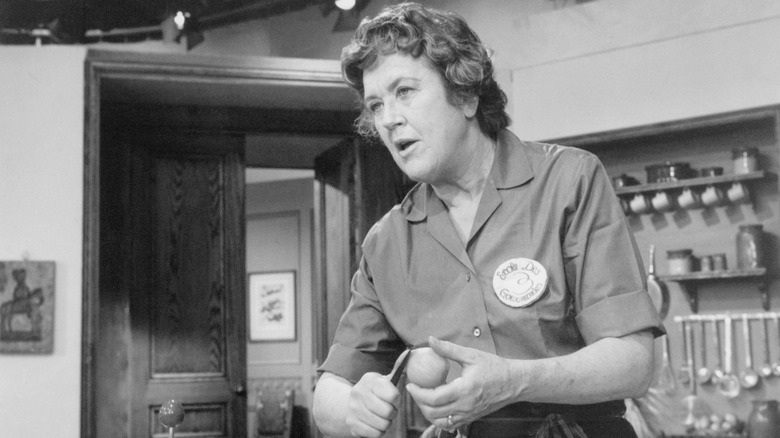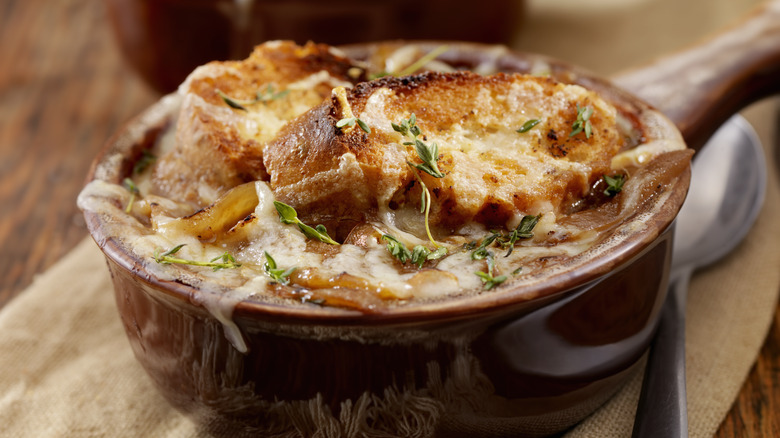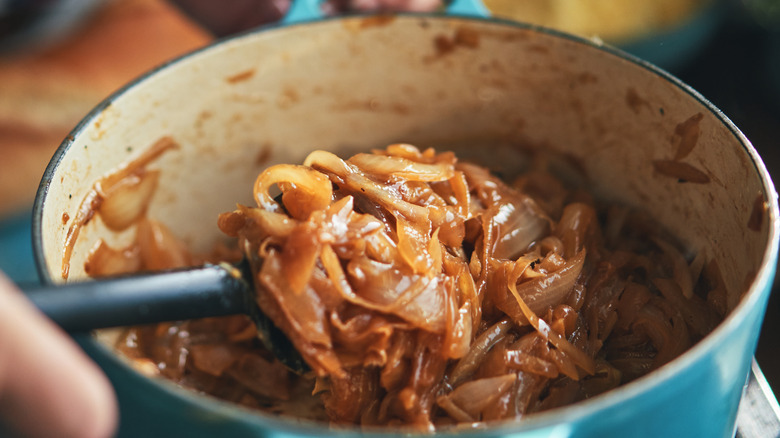Julia Child Added Brandy To Her French Onion Soup, And You Should Too
French onion soup might be as close to a hug in a bowl as you can get. Warm, savory, and filling with a complexity of flavors, it's a wonder that a French onion soup recipe is so simple to make. Of course there's a Julia Child recipe for this dish – and some might say hers is the definitive version. That's easy to believe, considering the many ways Child changed the way we cook. Published in 1961 in her canonized volume "Mastering the Art of French Cooking," Child's French onion soup recipe is everything you'd expect: well balanced, relatively straightforward, and a little boozy. If you're not making this recipe with dry white wine and cognac, you're not really making Julia Child's French onion soup.
You can use any brandy of your liking, but Child says cognac is the way to go (cognac being a type of brandy). Surprisingly, you're not deglazing the caramelized onions with the brandy — that's what the wine is for. Instead, the cognac is treated like a garnish and goes in with the cheese and the bread. But Child doesn't go for the cheesy topping overkill that so many other French onion soup recipes have fallen prey to. She directs you to ditch the Gruyère beret and instead finely grate the cheese into the soup to melt over your brandy and bread.
A soup fit for a king
French onion soup seems like a dish that modern French cuisine adopted, or a dish an American who loves French cuisine would try to pass off as being authentically French. But this couldn't be further from the truth. French onion soup is said to be the product of Les Halles, a 12th-century food market in Paris. The truth is, French onion soup's recipe is so ancient that no one can be sure where it originated — and the chances of it being made with cognac in a 12th-century peasant soup stall are pretty slim. Some say King Louis XV may be responsible for the more modern version of the recipe, but even that (certainly apocryphal) story doesn't include brandy, much less its fancier expression, cognac.
So, why does Julia Child's recipe include cognac — and calls for it to be added at the end of the process instead of as a way to deglaze the pan after caramelizing the onions and adding the flour? While we can't know for sure, it's likely that it all has to do with the flavor and aroma. Beyond the slight bite of alcohol, uncooked cognac will bring notes of apricot, caramel, and vanilla to the nose as well as the taste buds — a perfect complement to the onion's sweetness and the beef broth's earthiness. Child adds raw onions at the end too, probably intuitively recognizing that this dish needs some high notes for balance.
Patience and a lot of butter
Julia Child's French onion soup is a far cry from the stuff in medieval Paris soup stalls. It's wholly dependent on perfectly caramelized onions, and for that you need patience and a lot of butter. After the onions are a deep caramel brown, use wine to deglaze the pan (you can simply use broth for this process; it'll do basically the same thing). Deglazing is critical to the flavor development of the soup because it releases fond — a fancy term for the yummy brown bits of flavor stuck to the bottom of a pan. The booze will cook out, but the wine's flavor will contribute to the complexity of the broth.
You float the cognac on top of the soup just before serving it, so you won't be cooking out any of that alcohol. This will retain all the caramel flavor and warmth of the brandy, and this particular ingredient is best when you add it to taste. Child's recipe suggests ¼ cup, and perhaps that's a good place to start. Or you can use less if you're feeling dubious. But it's absolutely worth including for a delicious Julia Child-approved French onion soup on a cold winter evening.


